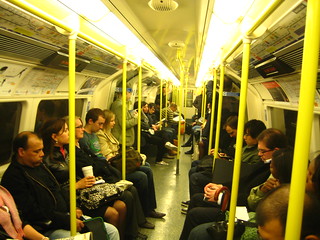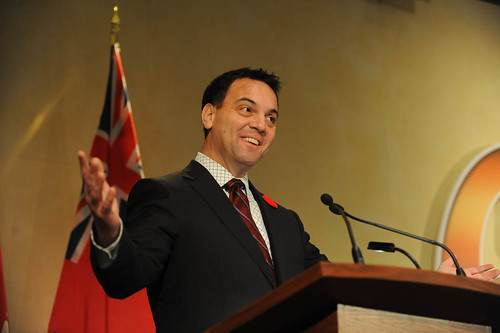As you might remember, the Northern Ontario ridings are a point of contention. With their vast territories and dwindling population, the question of how many ridings should be drawn for them is a sticking point for local residents (and MPs!).
A Brief History of Ridings
 |
| A scene from the Electoral Boundaries Commission's "Map Viewer" tool |
Compare this to the US, where a state like New Hampshire, which sends two representatives to the US House of Representatives, can have one of the largest state legislatures with 400 members.
In the 1990s, the number of MPPs in Ontario was cut down to the same number of federal MPs from the province.
Surprisingly, (as in we're surprised something so sensible could happen, given the circumstances) the provincial riding boundaries became identical to the federal ones.
The Plot Thickens
As the Elections Ontario website explains, in 2005, the Liberal government of Ontario decided to respond to the 2003 Federal redistricting, which took a federal seat away from the north, by keeping the number of provincial ridings in Northern Ontario fixed at 11.
Meanwhile, southern provincial seats were not locked in, and were allowed to shuffle to match the 2003 federal redistribution.
When the last reliable federal census was taken in 2006, the provincial riding boundaries in the North were based on the federal boundaries from before the 2003 Order. The provincial riding boundaries in the south of Ontario, meanwhile, were "identical to their federal counterparts, as they existed on September 1, 2004."
Minority Report
For our purposes, the Federal Electoral District (FED) reports based on the 2006 census can be used at the provincial level. We have to do this since Elections Ontario doesn't compile and release to the public reports based on the current provincial boundaries (as do Québec, British Columbia, etc), at least as far as we can tell.
The catch is that the 2006 FED reports can only really be used on the 96 southern provincial ridings.
The northern provincial ridings correspond to the older, 2001 FED reports.
As you might imagine, the data is slightly different, and 5 years older. Some of the questions that made it into the 2006 FED reports weren't in the 2001 versions, such as questions about transportation and housing.
In our data we've responded by essentially ignoring the Northern Ridings, or presenting them as a separate, but related data set. (That can't be what the government had in mind, can it?)
Episode II : Attack of the Commissions
This year, a new Representation Order at the federal level is due, which will give a greater number of seats to Ontario (121) in an expanded House of Commons (338 mps vs the current 308). The boundaries will have to be redrawn at the federal level.
The question is: what happens at the provincial level? Elections Ontario gives us some hints: "With the passing of Bill 214 and the Representation Act, 2005, Ontario’s electoral boundaries are no longer identical to the federal electoral boundaries."
Mmmkay. On continue...
The new electoral boundaries will remain until they are replaced by new legislation. Any changes to the names of southern electoral districts that may be made at the federal level after September 1, 2004 are also adopted at the provincial level, but only if the boundaries of the electoral district are unchanged. ('Tis we, who underline)New Legislation
The good people of Ontario, particularly the politically-minded, and those with websites, face the prospect of having to throw everything out and start again before the next provincial election (which could happen anytime, so, now, basically).
But things might not be so dire. As the Commission points out,
The new boundaries are applied at a general election called at least seven months after the representation order is proclaimed. (section 25)It is hard to see how Queen's Park would jump ahead of the Feds on this issue, particularly during a period of minority government instability.
This time allows Elections Canada, political parties, candidates and sitting MPs to prepare for the next general election (e.g. hire or reappoint returning officers, adjust the National Register of Electors, reorganize electoral district associations). The next general election is planned for October 2015.
The earliest a general election could be called where the new boundaries would take effect is April 2014.
On the other hand, as we'll point out, the new Wynne government could use the redistribution issue as an interesting gambit to try to win the next election.
Represent Your Hood
A common metric used to evaluate the democratic quality of a parliament, house, congress, etc. is the ratio of representatives to voters (or citizens). In Canada, there were 24,257,592 registered voters for the 2011 elections, and 308 MPs, for a ratio of 78,758:1.
Not every MP has 78,758 constituents (the boundaries commission is allowed to vary the number to meet certain other goals) but that's the rough number. Compare that to the US, where this website informs us there are 180,345,625 registered voters, for 435 congressmen. This makes for a ratio of 414,587:1. It's much harder to see your congressman than your MP, and it's much harder to get elected.
 |
| Goodbye, Trinity-Spadina |
It's conversely about twice as easy to get elected at the provincial level in Québec, and twice as easy to meet your MNA face-to-face. This makes sense, as provincial issues (health, education, etc) are "closer" to home and more frequent contact with voters seems desirable.
But consider the case of Ontario, as it will be after the federal redistribution, for its 8,761,095 voters:
8,761,095 voters for 121 Federal MPs, or about 72,406:1
8,761,095 voters for 107 Provincial MPPs, or about 81,879:1
With the unadjusted boundaries, Ontario will face the dubious honour of having a provincial parliament that is less representative than its deputation to the House of Commons.
Even belt-tightening Ontarians might agree that in a democracy, where the ideal ratio should (theoretically) be somewhat closer to 1:1, this isn't a desirable situation.
What to do about it - A Political Fiction Tale
Let's say you're a new Ontario premier, who is lagging in the polls. The seat projections at Ontario Projections aren't very favourable for you. What are some possible ways to avoid an election or gain more seats?
Shake up the map.
You could pass a bill adjusting the provincial boundaries to match the new federal boundaries ("Our federal friends have spoken, and opened the way to a new collaborative way of representing Ontarians in parliament.... " ).
Another option is to reopen the question for the whole province, or at least the southern ridings.
Should Queen's Park MPPs be elected from the same districts as their federal counterparts? Should the provincial legislature instead be more representative than the House of Commons?
Why not launch a round of public consultations on the Ontario Riding Question?
MPPs would likely love it, as they might find their re-election tasks will have become easier in short order. In any case, it would buy them some more time until the next election.
Voters would probably like it as well, as they'd get to have a say on the issue. Should our democracy really be based on the cheapest possible number of MPPs?
In the process, the government might be able to find new pockets of voters, who will then be able to express their heretofore pent-up Liberal votes (e.g. in the centers of towns of otherwise Tory ridings).
While we're at it
Maybe, just maybe, Elections Ontario could then be directed to produce new riding reports based on the 2006 census data (like the DGEQ did), and make them public and preferably in Excel format. It would be even more fun if they brought back the zip code to riding correspondence file. Just saying.




















